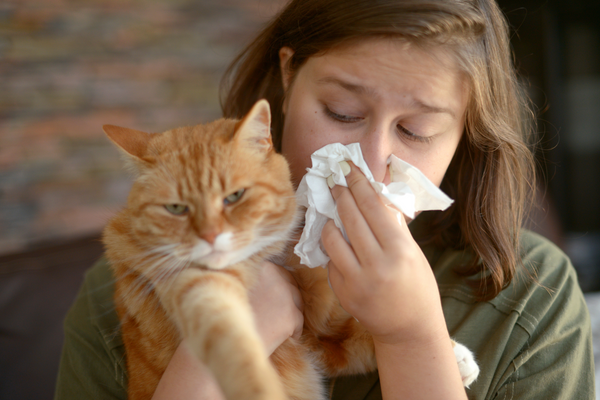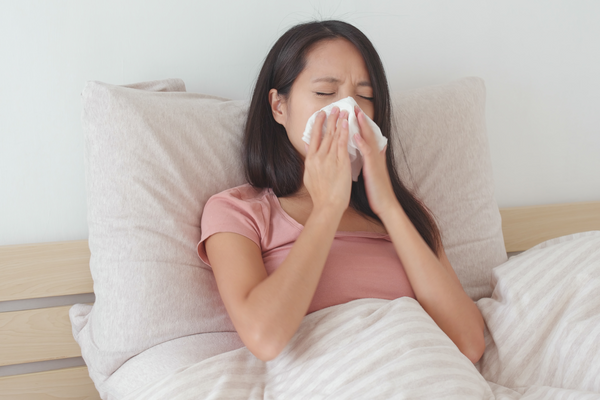Allergic to Your Pet? Easy Tips to Prevent & Control Your Allergy

If you could wave a magic wand and make your allergy symptoms disappear, you’d probably do it in a second. Allergies can make anyone miserable! But what if your beloved pet is the cause of your incessant sneezing, sniffling, watery eyes, and runny nose? Allergies to pets are incredibly common, especially among people who have other allergies or asthma. In the United States, as many as three in 10 people with allergies have allergic reactions to cats and dogs. However, that doesn’t necessarily stop people in this predicament from sharing a roof with one (or many) furry companions.
Thankfully, there are many solutions that can be explored that would allow an allergy sufferer to keep their cherished animal companions while successfully managing their allergies. In many cases, the benefits of having a pet outweigh the drawbacks of pet allergies.
In this article, we’ll give you some easy tips to reduce allergens in your home. But first, let’s talk about allergies and what causes those annoying symptoms.
What Are Allergies?
In short, allergies are reactions that occur when the body’s natural defenses (immune system) overreact to a foreign substance called an allergen. Allergens themselves are usually harmless; it’s our body’s extreme response to them that causes the unwanted symptoms. Allergies can develop at any age.
Our immune system can create unique proteins called antibodies that are programmed to recognize and respond to a specific allergen, even one that we have been around our entire lives. When this occurs, it’s called sensitization. The next time the person is exposed to that allergen, the immune system recognizes it and attacks, causing an allergic reaction with associated symptoms. Though anyone can develop allergies at any time, some families are more prone to them. While individuals don’t inherit an allergy to a specific allergen, the overall likelihood of developing allergies is increased when other family members have allergies.
What Are Allergens?

Most allergens are proteins. Common sources of allergens include pollens, mold spores, dust mites, cockroaches, or animals. Animal allergens are typically found in urine, saliva, skin, and feces; and can be carried on hair and dander (tiny scales from skin, hair, or feathers).
Allergens from pets are small and lightweight, so once they’re in the air, they can remain suspended for long periods of time eventually settling down on carpets, bedding, furniture, and other items in the home. Additionally, people can carry pet allergens on their hair and clothing.
How Common Are Allergies to Pets?
It’s estimated that 30 to 40% of the world’s population suffers from one or more allergic disorders, and the prevalence of allergies has been rising worldwide. Among U.S. citizens of all ages, allergies are the fifth leading cause of chronic diseases, and asthma (often triggered by allergies) is the third most common chronic disease in children under eighteen years old. In addition, the Asthma and Allergy Foundation of America (AAFA) reports that allergies to pets are very common, affecting millions of Americans. An estimated 15 to 30% of people with allergies have a reaction to cats or dogs, with cat allergies being twice as common as dog allergies.
In the case of pets, the allergy has nothing to do with fur, as many people believe. Rather, it comes down to animal dander, an otherwise harmless protein found in a pet’s skin, saliva, and urine, according to the Mayo Clinic. The allergens can then be deposited on the animal’s fur through licking. Once the fur dries, the particles can flake off and become airborne. So, that means, your beloved pet can spread his dander all over your home when he scratches behind his ears, chases a favorite toy, rolls around on the living room rug, and all the other ways he lives a delightful animal life. How lovely!
It’s easy to only think of dander and allergies when it comes to cats and dogs, but there is a whole world of pet possibilities out there. Rabbits, guinea pigs, horses, parakeets… pretty much every animal with fur or feathers has dander, according to Alice Hoyt, M.D., an allergist in the allergy and clinical immunology department at Cleveland Clinic.
Another common misconception is that there are hypoallergenic breeds of dogs and cats. Unfortunately, this is simply not true. All dogs, cats, and other warm-blooded pets (and most birds) produce allergens. The level of different types of allergens may vary between individual animals, but this is not due to a specific gender, breed, or breed mix. Some allergic individuals tolerate some breeds better than others due to variations in amounts and types of allergens produced. However, in spite of advertising claims and higher prices, no four-legged fur babies are truly hypoallergenic. A 2011 study published in the American Journal of Rhinology and Allergy looked at 190 one-dog homes and found no difference in the concentration of allergens in homes with “hypoallergenic” breeds compared to other dog breeds. This makes perfect sense, because length of fur, shedding, and other similar variables don’t affect the amount of dander a pet has, according to the American Academy of Allergy Asthma & Immunology (AAAAI).
What Are Symptoms to Pet Allergies?
Pet allergies typically cause nose, eye, skin, and respiratory (lung and throat), symptoms. These may lead to a decreased quality of life, including difficulty sleeping and a lack of energy. According to the American College of Allergy, Asthma, & Immunology (ACAAI), here are some common pet allergy symptoms.
Nose and eye symptoms may include:
- Sneezing
- Runny or stuffy nose
- Red, itchy, or watery eyes
- Itchy nose, throat, or roof of mouth
Skin symptoms may include:
- Dry, itchy skin
- Rashes and or hives
Those whose pet allergies trigger allergic bronchitis or asthma, may also develop the following respiratory symptoms:
- Cough
- Wheezing when breathing
- Chest tightness
- Shortness of breath
In extreme pet allergy cases, a severe reaction can occur, known as anaphylaxis, in which the allergic individual may experience itching, hives, swelling, respiratory distress, shock, and even death. In general, symptoms will worsen when a person is exposed to greater amounts of allergens or when several different types are present. Therefore, reducing the exposure to allergens can reduce the severity of the symptoms.
Reduce Your Exposure to Allergens with These Allergy Prevention Tips:

Reducing the amount of allergens in your household can dramatically reduce symptoms of allergies. Best results in reducing allergens are found when the recommendations listed here are applied consistently over time. In all cases, talking with your doctor is highly recommended; as some people may benefit from prescription medicine, allergy immunotherapy (allergy shots), or other medical treatments. Some with severe allergies and asthma may be discouraged from owning pets; however, most people can effectively manage their symptoms.
- Bathe pets regularly (ideally at least once a week) with an Anti-Allergen Pet Shampoo to remove allergens from their fur. Our Anti-Allergen Pet Shampoo neutralizes allergens in pet dander and dust mite allergens, while cleaning and conditioning for an extra-soft, fresh-smelling coat. The 100% biodegradable plant and mineral-based formula also makes our pet shampoo an environmentally-friendly choice.
- Limit pets’ access to bedrooms. Airborne pet allergen levels have been found to be much higher in rooms where animals are physically present.
- Avoid “dry” cleaning (brooms and feather dusters) which can aerosolize pet allergens. Instead, clean with wet supplies such as damp cloths and mops which will trap and remove allergens.
- Vacuum regularly, at least once a week, with a vacuum cleaner that is equipped with a HEPA filter to prevent outflow of the contents (including pet allergens) that have been swept up.
- When laundering bedding, clothing, rugs, and other washable items (including pet beds) use an Anti-Allergen Laundry Detergent to provide relief for allergy sufferers. Our Anti-Allergen Laundry Detergent removes allergens such as dust mite waste, mold, mildew, smoke, pollen, and pet dander on all types of clothing and bedding. This 100% biodegradable plant and mineral-based formula naturally removes the allergen while leaving your washables fresh, clean, and soft. Our Anti-Allergen Laundry Detergent is effective in cold, warm, or hot water.
- In addition to using a HEPA filter in household heating and cooling systems, the use of an air purifier with a HEPA filter in the room where pets spend the most of their time will reduce the concentration of allergens floating in the air.
- Clear away clutter. Less stuff around the home makes it easier to clean and get rid of pet dander.
- Use an Anti-Allergen Solution to eliminate allergens from furniture, bedding, rugs, carpeting, upholstery, pet beds and more. Our Anti-Allergen Solution is 100% biodegradable, made with a plant and mineral-based solution. It’s free of fragrances and other ingredients that can make allergic reactions worse. The non-toxic, hypoallergenic formula is also safer for the planet, so you can feel good about spraying it liberally.




